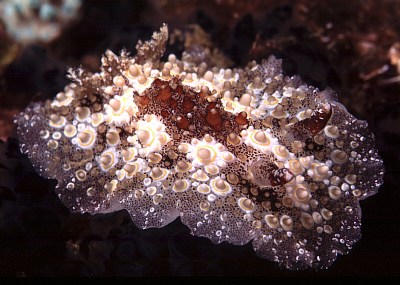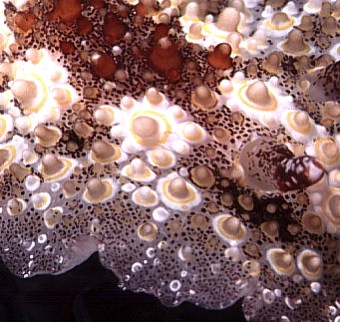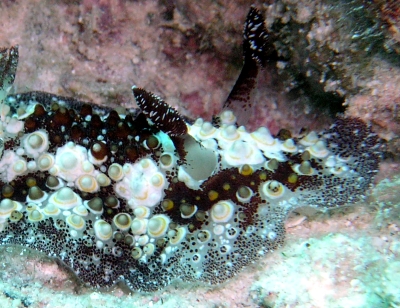

Hoplodoris estrelyado
Gosliner & Behrens, 1998
Order: NUDIBRANCHIA
Suborder: DORIDINA
Superfamily: EUDORIDOIDEA
Family: Dorididae
DISTRIBUTION
Indo-West Pacific (Western Australia, Vietnam, Philippines, Indonesia, Marshall Ids).
PHOTO
Batangas, Philippines, 25 ft, 20-25 mm long. May, 2000. Photo: M.D.Miller.
See message below.
Reference:
• Gosliner, T.M. & Behrens, D.W. (1998) Two New Discodorid Nudibranchs from the Western Pacific with a Redescription of Doris luteola Kelaart, 1858. Proceedings of the California Academy of Sciences, 50(11): 279-293.
Rudman, W.B., 2000 (July 1) Hoplodoris estrelyado Gosliner & Behrens, 1998. [In] Sea Slug Forum. Australian Museum, Sydney. Available from http://www.seaslugforum.net/find/hoplestr
Related messages
First record of Hoplodoris estrelyado from the Red Sea
May 22, 2007
From: Sven Kahlbrock


Hello Bill,
Some guests of mine found this small slug. To me it looks like Hoplodoris nodulosa, but it should not be common in our area. are there some other reports from it here?
Locality: Marsa Abu Galawa, hurghada, 14m, Egypt, Red Sea, 31 december 2006, sandbottom with some coral. Length: aprox. 5 cm. Photographer: Marion Streilein.
With best regards,
Sven Kahlbrock
s_kahlbrock@web.de
Kahlbrock, S., 2007 (May 22) First record of Hoplodoris estrelyado from the Red Sea. [Message in] Sea Slug Forum. Australian Museum, Sydney. Available from http://www.seaslugforum.net/find/19146
Dear Sven,
This is an interesting find. It is a species of Hoplodoris but it is not H. nodulosa. From the colour pattern of white patches, and small brown specks and yellow rings around the base of the pustules, this can only be Hoplodoris estrelyado. What is interesting is that it has only previously been reported from the western Pacific. Your record from the Egyptian Red Sea increases its distribution to the other side of the Indian Ocean.
Best wishes,
Bill Rudman
Hoplodoris estrelyado from NE Bali, Indonesia
May 22, 2007
From: Lindsay Warren

Dear Bill
Just thought you might like these shots of a Hoplodoris estrelyado I found while diving off NE Bali, Indonesia for records from different localities. It seemed to have been damaged on the left side at the gill level - perhaps it had been picked up off the reef and redeposited in the open by its attacker.
Locality: Noisy Reef, Tukad Dabu, 51 ft / 5.2 m, NE Bali, Indonesia, Tropical Western Pacific, 10 May 2006, 10:20 am, On sand & silt slope in open away from reef. Length: 18 mm. Photographer: Lindsay Warren.
All the best
Lindsay
lwarren@datonomy.co.uk
Warren, L.C.R., 2007 (May 22) Hoplodoris estrelyado from NE Bali, Indonesia. [Message in] Sea Slug Forum. Australian Museum, Sydney. Available from http://www.seaslugforum.net/find/19180
Thanks Lindsay,
It could well have been damaged by an inquisitive fish
Best wishes,
Bill Rudman
Hoplodoris estrelyado from Bali
May 22, 2007
From: Erwin Kodiat

Hi Bill,
I found this in Bali earlier this year. I suspected it is Hoplodoris nodulosa, but the locality in this forum shows that H. nodulosa is from Australia and New Zealand. Can you verify it for me?
Locality: Seraya, 5 meters, Bali, Indonesia, Lombok Strait, 7 January 2007, Rocks. Length: 30 mm. Photographer: Erwin Kodiat.
Thanks
Erwin Kodiat
nudibranch@kapalselam.org
Kodiat, E., 2007 (May 22) Hoplodoris estrelyado from Bali. [Message in] Sea Slug Forum. Australian Museum, Sydney. Available from http://www.seaslugforum.net/find/19169Dear Erwin,
This is another species of the genus -Hoplodoris estrelyado.
Best wishes,
Bill Rudman
Hoplodoris estrelyado from the Philippines
June 30, 2003
From: Vasa P. Sirinupongs


Hi Bill,
Here is a nuidbranch from the Philippines.
Length: 1.5-2 inch
Depth: 18m
Site: Dumaguete, Philippines
Date: May 2003
Regards,
Vasa
photo@scubadiving.com
Sirinupongs, V.P., 2003 (Jun 30) Hoplodoris estrelyado from the Philippines. [Message in] Sea Slug Forum. Australian Museum, Sydney. Available from http://www.seaslugforum.net/find/10340Dear Vasa,
This is Hoplodoris estreylado.
Best wishes,
Bill Rudman
Hoplodoris estrelyado mating
December 30, 2002
From: Mary Jane Adams

Hi Bill,
This picture is difficult to decipher due the the camouflage pattern of Hoplodoris estrelyado. If you look closely you can see two slugs in the mating position. The largest one was about 2cm long.
Depth: about 20 meters.
Divesite: Nudi Falls, Lembeh Strait, Sulawesi
Island, Indonesia. Nov. 18, 2002.
Best regards,
Mary Jane
divepng@yahoo.com
Adams, MJ., 2002 (Dec 30) Hoplodoris estrelyado mating. [Message in] Sea Slug Forum. Australian Museum, Sydney. Available from http://www.seaslugforum.net/find/8728Thanks Mary Jane,
Its interesting, and accurate, for you to describe the colour pattern of this species as a 'camouflage pattern'. When we look at a photograph of a brightly coloured and spectacularly patterned animal such as this, it is easy to forget that many of these animals in their natural habitat are in fact very difficult to see. The bold and opposing colour bands help to break up the bulk, and the shape of the animal and so fool potential predators.
best wishes,
Bill Rudman
Hoplodoris estrelyado from Lembeh Strait
December 9, 2002
From: Mary Jane Adams

Hi Bill,
Hoplodoris estrelyado lives in Lembeh Strait, Sulawesi Island, Indonesia. I found this one November 18, 2002 at divesite Nudi Falls.
It was about 25 mm long and about 15 meters deep. It's elaborate pattern makes very good camouflage. From the reports that are trickling in to the Forum, it appears that, although rare, it has a wide distribution.
Best regards,
Mary Jane
divepng@yahoo.com
Adams, MJ., 2002 (Dec 9) Hoplodoris estrelyado from Lembeh Strait. [Message in] Sea Slug Forum. Australian Museum, Sydney. Available from http://www.seaslugforum.net/find/8615Thanks Mary Jane,
Bill Rudman
Hoplodoris estrelyado from Solomon Ids
November 30, 2002
From: Bruce Potter


Dear Bill,
I found this Hoplodoris estrelyado on a coral and rubble site near Honiara recently. It was at about 15 meters crawling across sand.
Normally the ones I see here are about 15mm long, but this one was about 25mm. It may not have chosen to crawl across the leaf had I not encouraged it to do so. It gives a much better outline of the otherwise well camouflaged body.
Regards,
Bruce Potter
bruce.potter@adventist.org.sb
Potter, B., 2002 (Nov 30) Hoplodoris estrelyado from Solomon Ids. [Message in] Sea Slug Forum. Australian Museum, Sydney. Available from http://www.seaslugforum.net/find/8522
Thanks Bruce,
I have included a closeup alongside to show more clearly the quite elaborate colour pattern found in this species.
Best wishes,
Bill Rudman
Hoplodoris estrelyado from the Solomons
February 21, 2001
From: Bruce Potter

Dear Bill,
I have seen this very pretty nudibranch several times here, and originally identified it from Debelius' book as Hoplodoris nodulosa. However after seeing Mary Jane's Hoplodoris estrelyado I guess it is actually that.
Filmed at Honiara, Solomon Islands, in about 6 meters on a rubble site. February 2001
Regards
Bruce Potter.
bruce.potter@adventist.org.sb
Potter, B., 2001 (Feb 21) Hoplodoris estrelyado from the Solomons. [Message in] Sea Slug Forum. Australian Museum, Sydney. Available from http://www.seaslugforum.net/find/3834Dear Bruce,
It is indeed Hoplodoris estrelyado, and the side view gives us a good view of the tubercular nature of the mantle.
Best wishes,
Bill Rudman
Hoplodoris estrelyado from the Coral Sea
February 16, 2001
From: Mary Jane Adams

Hi Bill,
I believe this is Hoplodoris estrelyado. I photographed it on Marion Reef in the Coral Sea in November, 1991. It was not on this coral when it was found. Length: 42 mm Depth unrecorded
Best regards,
Mary Jane
divepng@yahoo.com
Adams, M.J., 2001 (Feb 16) Hoplodoris estrelyado from the Coral Sea. [Message in] Sea Slug Forum. Australian Museum, Sydney. Available from http://www.seaslugforum.net/find/3671Dear Mary Jane,
Yes this is Hoplodoris estrelyado
Bill Rudman
Hoplodoris estrelyado from Marshall Ids
July 10, 2000
From: Scott Johnson


Hi Bill,
Mike's picture is nicer, but here's one that will at least confirm that Hoplodoris estrelyado has yellow rings. The rings are present on all the individuals I've found here in the Marshalls. This somewhat confusing shot shows three of the nudibranchs clustered together.
Scott
johnson@kmr.ll.mit.edu
Johnson, S., 2000 (Jul 10) Hoplodoris estrelyado from Marshall Ids. [Message in] Sea Slug Forum. Australian Museum, Sydney. Available from http://www.seaslugforum.net/find/2685Thanks Scott,
Am I imagining it or does it have rather large rhinophore clubs as well?
Cheers,
Bill Rudman.
Hoplodoris estrelyado from Philippines
July 2, 2000
From: Mike Miller


Dear Bill
Here is an image of Hoplodoris estrelyado for the Sea Slug Forum!
Animal was photographed on the tunicate Sigillina signifera which could be a food source for this animal. S. signifera certainly is a popular prey item among the larger Nembrothids seen in the Batangas region of the Philippines.
Location: Batangas, Philippines
Date: May, 2000
Size: 20-25 mm
Depth: 25 ft.
Reference:
Gosliner, T.M. & Behrens, D.W. (1998) Two New Discodorid Nudibranchs from the Western Pacific with a Redescription of Doris luteola Kelaart, 1858. Proceedings of the California Academy of Sciences, 50(11): 279-293, 7 Figs.
Cheers,
Mike Miller
mdmiller@cts.com
Miller, M.D., 2000 (Jul 2) Hoplodoris estrelyado from Philippines. [Message in] Sea Slug Forum. Australian Museum, Sydney. Available from http://www.seaslugforum.net/find/2645Dear Mike,
Thanks for the photo. Are the yellow rings around the tubercles usual? I don't see any mention of them in the original description. It is quite a spectacular animal in close-up.
Best wishes,
Bill Rudman.
